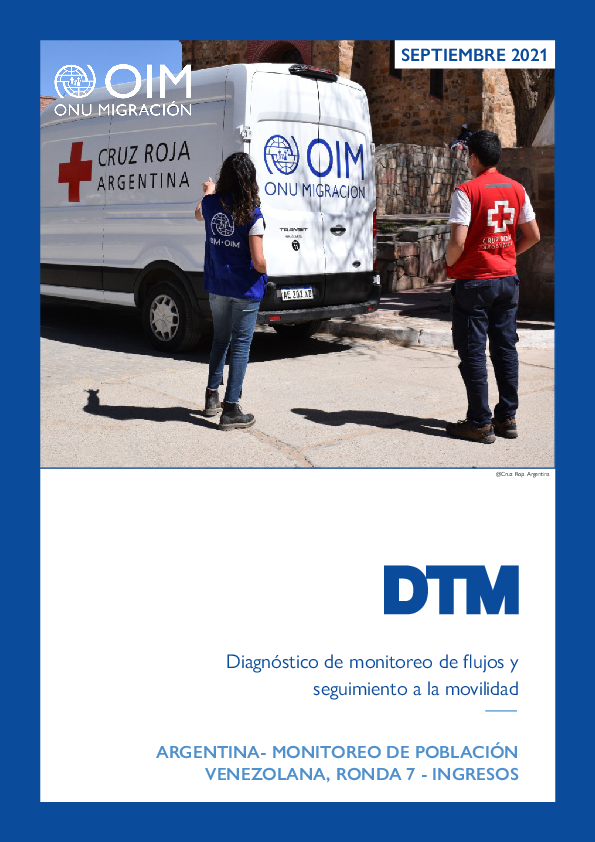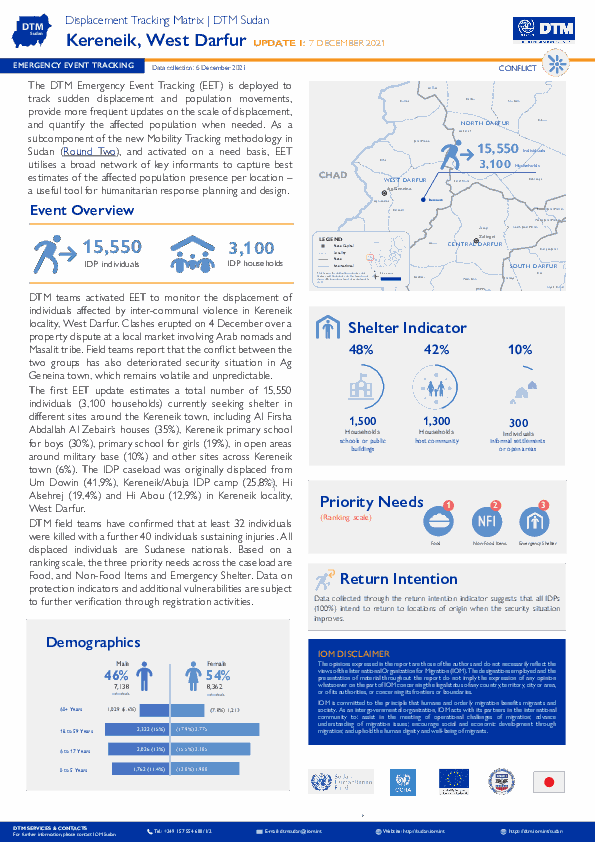-
Countries
-
Data and Analysis
-
Special Focus
-
Crisis Responses

Contact
iomiranmedia@iom.int
Language
English
Location
Iran (Islamic Republic of)
Period Covered
Jan 01 2020
Dec 31 2020
Activity
- Flow Monitoring
This snapshot summarizes available data on Iranian nationals in Europe in 2020. The first page visualizes the number of Iranian nationals who arrived by land and sea in the European Union and those who transited through the Western Balkan and Eastern Europe region in 2020. The data on arrivals and transits is made available by national authorities and then gathered by the IOM DTM Team in Europe.1 It is important not to sum up the figures, as this could entail double counting migrants who transited through multiple countries. The second page shows numbers of Iranian nationals residing in Europe by gender and European region as reported by UNDESA.
The snapshot is part of the outputs of the EU-funded Displacement Tracking Matrix (DTM) project “Regional Evidence for Migration Analysis and Policy” (REMAP). The objective of DTM REMAP is to strengthen the evidence-based formulation and implementation of humanitarian and development policy and programming on migration and forced displacement in Afghanistan, Bangladesh, the Islamic Republic of Iran, Iraq and Pakistan.
Contact
DTM Mozambique, DTMMozambique@iom.int
Location
Mozambique
Activity
- Site Assessment
- Mobility Tracking
Period Covered
Sep 22 2021 -Oct 23 2021
KMZ is a file extension for a placemark file used by Google Earth. KMZ stands for Keyhole Markup language Zipped. It is a compressed version of a KML (Keyhole Markup Language) file. Keyhole was the founding company of the Earth Viewer software that Google Earth was built upon.
KMZ files can contain placemarks featuring a custom name; the latitudinal and longitudinal coordinates for the location, and 3D model data. KMZ files can be opened by Google Earth, or unzipped with a compression utility, such as WinZip on Windows, MacZip for Macintosh users, and Zip and UnZip for UNIX systems.
Population Groups
Survey Methodology
Unit of Analysis Or Observation
Type of Survey or Assessment
Keywords
Geographical Scope
Administrative boundaries with available data
The current dataset covers the following administrative boundaries
Contact
DTM Mozambique, DTMMozambique@iom.int
Location
Mozambique
Activity
- Site Assessment
- Mobility Tracking
Period Covered
Oct 22 2021 -Oct 23 2021
A site assessment is a sub-component of mobility tracking. It aims to collect data on population presence, living conditions and needs in a particular displacement site or community.
Population Groups
Survey Methodology
Unit of Analysis Or Observation
Type of Survey or Assessment
Keywords
Geographical Scope
Administrative boundaries with available data
The current dataset covers the following administrative boundaries

Contact
DTM Mozambique, DTMMozambique@iom.int
Language
English
Location
Mozambique
Period Covered
Sep 22 2021
Oct 23 2021
Activity
- Site Assessment
- Mobility Tracking
From 22 September to 23 October 2021, in close coordination with provincial government and INGD partners, the International Organization for Migration (IOM)’s Displacement Tracking Matrix (DTM) teams conducted Multi-Sectoral Location Assessments (MSLA) in 59 sites hosting 192,721 internally displaced persons (IDPs) in Cabo Delgado province, 1 site with 5,934 IDPs in Nampula province, and 2 sites with 336 IDPs in Niassa province, in response to the mass displacements caused by the insecurity situation in the north. In all sites, the majority of IDPs were displaced by the insecurity situation. Of the total 198,991 individuals in the assessed sites, 62,045 (or 31%) are women, 32,022 (16%) are men, and 107,948 (53%) are children.

Contact
dtmmediterranean@iom.int
Language
Bosnian, Croatian, Serbian
Location
Bosnia & Herzegovina
Snapshot Date
Nov 09 2021
Activity
- Flow Monitoring
- Migrants presence
09 novembra 2021, sedma zajednička vježba provedena je od strane IOM-a u Bosni i Hercegovini (BiH) zajedno sa Službom za poslove sa strancima1 (SPS), uz podršku Crvenog križa (CK) Federacije BiH (FBiH) kako bi prikupili informacije o broju migranata i tražioca azila2 koji se trenutno nalaze u državi. Svrha ove vježbe je da se pruži okvirni broj migrantske populacije koja nije smještena niti registrovana u jednom od Privremenih prihvatnih centara (PPC) u datom trenutku. Sačinjeno je devet timova od ukupno 28 popisivača (22 muškaraca i 6 žena), uz dodatnih 11 inspektora SPS-a (8 muškaraca i 3 žene) i 10 uposlenika CK (6 muškaraca i 4 žene). Vježba prikupljanja podataka je implementirana u 6 kantona, 32 općine, na ukupno 187 lokacija, i to: 77 lokacija u 7 općina Unsko-sanskog kantona, 48 lokacija u 10 općina Tuzlanskog kantona, 21 lokacija u 4 općine Kantona Sarajevo, 22 lokacije u 5 općina Hercegovačko-neretvanskog kantona, 4 lokacije u 4 općine Zapadno-hercegovačkog kantona i 2 lokacije u 2 općine u Kantonu 10.
Ukupni broj identifikovanih migranata na posjećenim lokacijama je 585 od kojih je 578* izjavilo da nisu smješteni u ni u jednom od postojećih PPC-a u BiH.

Contact
dtmmediterranean@iom.int
Language
English
Location
Bosnia & Herzegovina
Snapshot Date
Nov 09 2021
Activity
- Migrants presence
- Mobility Tracking
On 09 November 2021, a seventh joint data collection exercise was conducted by IOM Bosnia and Herzegovina (BiH), together with the Service for Foreigners’ Affairs1 (SFA), and the support of the Red Cross (RC) Federation of BiH (FBiH) to collect information on the number of migrants and asylum seekers present in the country. The purpose of the exercise was to provide an estimate of the migrant population (stock) that was not accommodated or registered in any official Temporary Reception Centres (TRCs) at a given point in time. Nine teams were established for a total of 28 enumerators (22 M and 6 F), plus 11 SFA staff (8 M and 3 F) and 10 RC staff (6 M and 4 F). The data collection exercise was implemented in 6 Cantons, in 32 Municipalities for a total of 174 locations: 77 locations in 7 Municipalities in Una-Sana Canton, 48 locations in 10 Municipalities in Tuzla Canton, 21 locations in 4 Municipalities in Canton Sarajevo, 22 locations in 5 Municipalities in Herzegovina – Neretva Canton, 4 locations in 4 Municipalities in West Herzegovina Canton and 2 locations in 2 Municipalities in Canton 10.
The total number of migrants identified in the locations covered was 585 out of which 578 stated that they were not accommodated in any of official TRCs in BiH.

Contact
iombuenosaires@iom.int
Language
Spanish
Location
Argentina
Period Covered
Sep 07 2021
Oct 07 2021
Activity
- Survey
- Flow Monitoring Survey
En la actualidad se estima que aproximadamente 5.6 millones de personas de nacionalidad venezolana residen fuera de su país, de las cuales 4.6 millones residen en países de América Latina y el Caribe. En la República Argentina, se estima que residen 174.333 personas venezolanas, siendo este flujo poblacional uno de los más dinámicos en años recientes en un país históricamente receptor de inmigración.
En la DTM Ronda 7 se implementó la metodología de encuestas no probabilísticas, por conveniencia, tomadas de modo presencial en cooperación con Cruz Roja Argentina. De este modo, se alcanzó a una población de 105 personas a partir de 46 encuestas en un punto de la frontera norte de la República Argentina: La Quiaca, en la provincia de Jujuy. La población objetivo de este ejercicio fueron las personas migrantes y refugiadas de nacionalidad venezolana y el grupo familiar con el que se encontraban viajando, que ingresaron a la República Argentina entre el 7 de septiembre y el 7 de octubre de 2021.

Contact
DTM Somalia, IOMSomaliaDTM@iom.int
Language
English
Location
Somalia
Period Covered
Oct 01 2021
Oct 31 2021
Activity
- Flow Monitoring
In October 2021, a total of 26,092 movements were observed at 7 Flow Monitoring Points (FMPs). This represents an increase of 35 per cent in comparison with October 2020 (6 months after the country’s first case of COVID-19) when 19,392 movements were observed.
Out of the total observed movements, 41% were forced movements: 17% due to natural disaster (64% of them originated from Somalia), 12% due to food insecurity (66% of them originated from Ethiopia) and another 12% due to conflict (76% of them originated from Ethiopia).

Contact
DTM Ethiopia, SLOAddisAbabaDTM@iom.int
Language
English
Location
Ethiopia
Period Covered
Oct 01 2021
Oct 31 2021
Activity
- Flow Monitoring
In October 2021, a total of 14,227 movements were observed across four of Ethiopia's flow monitoring points (FMPs). It should be noted that data collection at Humera and Galafi Flow Monitoring Points in Tigray and Afar regions respectively did not take place due to security and access constraints, thus affecting the total number of movements for the month. This represents a 34.2% decrease in daily average movements in comparison with September 2021 when an average of 697 movements per day were observed.
Despite the decrease in movements this month, outgoing movements during October have continued to be higher than ever (87.9%) than incoming movements (12.1%). The proportion of outgoing versus incoming movements has continued to climb even above the proportions observed prior to the outbreak of COVID-19 in Ethiopia. A total of 12,505 outgoing movements were observed of which 4,353 (34.8%) were heading towards the Kingdom of Saudi Arabia, 2,702 (21.6%) were going to Kenya, 1,154 (9.2%) were travelling towards South Africa, 1,150 (9.2%) to Djibouti, 633 (5.1%) intended to reach the United Arab Emirates, and 439 (3.5%) headed to Qatar.

Contact
DTM Sudan; dtmsudan@iom.int
Language
English
Location
Sudan
Snapshot Date
Dec 06 2021
Activity
- Event Tracking
- Mobility Tracking
The DTM Emergency Event Tracking (EET) is deployed to track sudden displacement and population movements, provide more frequent updates on the scale of displacement, and quantify the affected population when needed. As a subcomponent of the new Mobility Tracking methodology in Sudan (Round Two), and activated on a need basis, EET utilises a broad network of key informants to capture best estimates of the affected population presence per location – a useful tool for humanitarian response planning and design.
